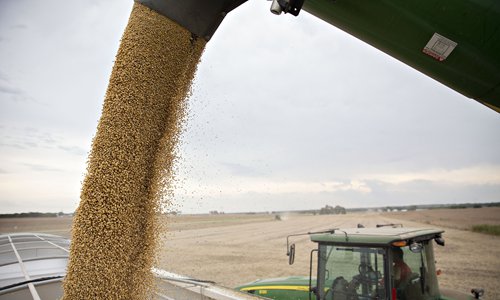HOME >> BUSINESS
US soybean futures rise over 2 pct weekly on trade optimism
Source:Xinhua Published: 2019/10/13 8:04:12

Soybeans are loaded into a grain cart during harvest in the US state of Illinois in 2018. Photo: VCG
Chicago Board of Trade (CBOT) agricultural futures settled higher for the trading week which ended on Oct. 11, with soybean futures surging over two percent on positive prospect of trade talks between China and the US.
The most active corn contract for December delivery was up 13 cents, or 3.38 percent week on week, to close at 3.9775 dollars per bushel on Friday. November soybeans were up 19.75 cent, or 2.16 percent, to settle at 9.36 dollars per bushel. December wheat was up 17.5 cents, or 3.57 percent, to close at 5.08 dollars per bushel.
China and the United State achieved substantial progress in multiple areas after holding a new round of high-level economic and trade consultations on Thursday and Friday in Washington.
The areas included agriculture, intellectual property rights protection, exchange rate, financial services, expansion of trade cooperation, technology transfer and dispute settlement.
CBOT agricultural futures ended mixed on Monday, with corn futures rising on worries about forecasts for wintry weather in the US Midwest that could slow harvest.
Soybean futures ended slightly lower despite fresh crop export sales to China.
The US Department of Agriculture (USDA) said on Monday that private exporters reported the sale of 198,000 metric tons of soybeans to China for delivery in the 2019/20 marketing year.
Another sale of 240,000 metric tons of US soybeans was reported for delivery to unknown destinations.
CBOT agricultural futures ended higher on Tuesday, with soybean futures rising on technical buying and weather concerns.
Corn futures received support from forecasts for wintry weather in western and northern stretches of the US Midwest that could slow harvest.
Only 15 percent of the US corn crop was harvested as of Sunday, behind the average pace of 27 percent, according to the USDA. About 14 percent of soybeans were collected, well behind the normal 34 percent for this time of year.
Wheat futures rallied as investors scrambled to cover bearish positions after the market passed through key resistance points.
CBOT agricultural futures settled mixed on Wednesday, with soybean futures edging higher on trade optimism and weather concerns.
Soybeans were higher on optimism about progress in US trade talks with China, the world's top soy buyer, along with traders' fears that a winter storm in the US Midwest could threaten late-maturing crops.
Wheat and corn futures were little changed, consolidating after touching near two-month highs and ahead of a governmental crop report due later in the week.
CBOT agricultural futures settled lower on Thursday, with corn futures plunging over 3 percent after a US governmental crop report raised its yield estimate.
The USDA, in its monthly supply and demand report released on Thursday, pegged the US corn yield at 168.4 bushels per acre, compared with 168.2 bushels in September. Analysts were expecting a cut to 167.5 bushels.
Poor export demand and investors' profit taking also pressured the corn market.
The USDA said Thursday that corn export sales totaled 284,400 metric tons for the week ending Oct. 3, below the low end of forecasts that ranged from 500,000 metric tons to 800,000 metric tons.
The losses of corn dragged down soybean futures, which earlier approached a three-month high on lower-than-expected US yield in the report.
The USDA reduced its soybean yield estimate to 46.9 bushels per acre from 47.9 bushels last month. Analysts were expecting 47.3 bushels.
CBOT agricultural futures settled higher on Friday, with corn futures surging over 4 percent on trade optimism and weather concerns.
Soybean futures rose as traders are awaiting more information about the latest round of trade talks between China and the United States. Lower yield estimate also supported the market.
Wheat futures rallied on bargain buying, short covering and spillover effect from higher corn and soybeans.
Posted in: INDUSTRIES,BIZ FOCUS